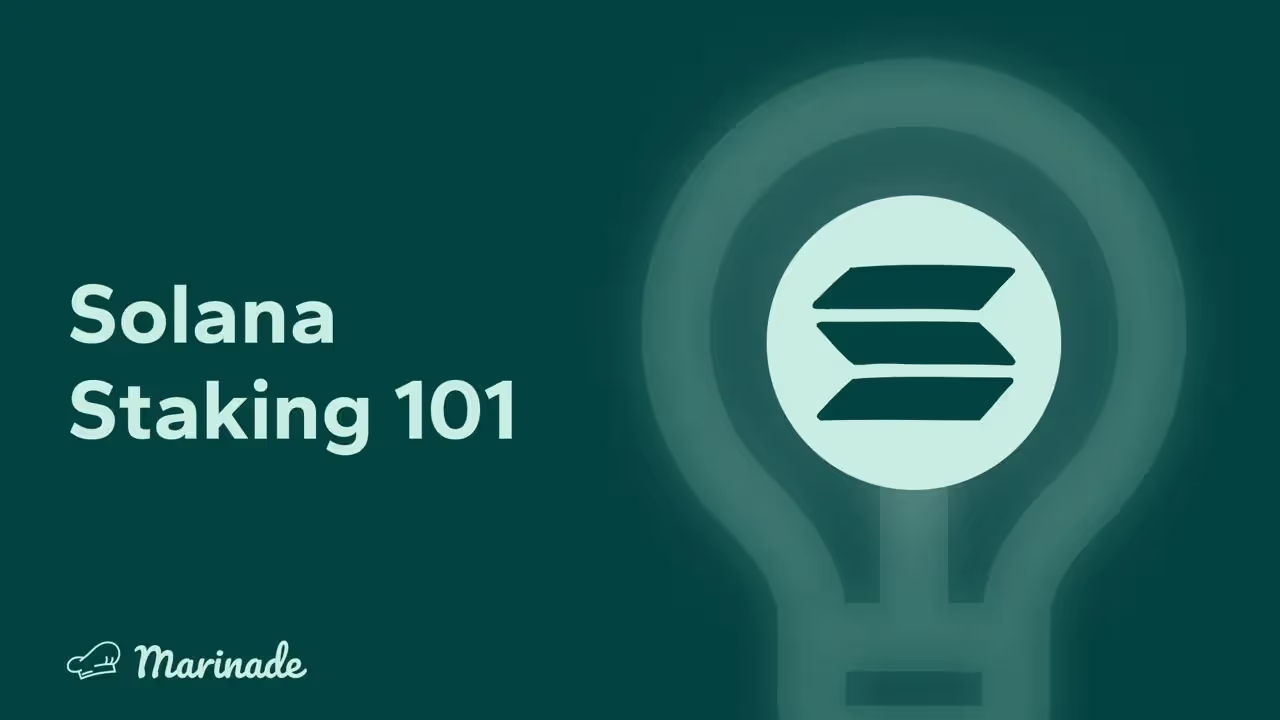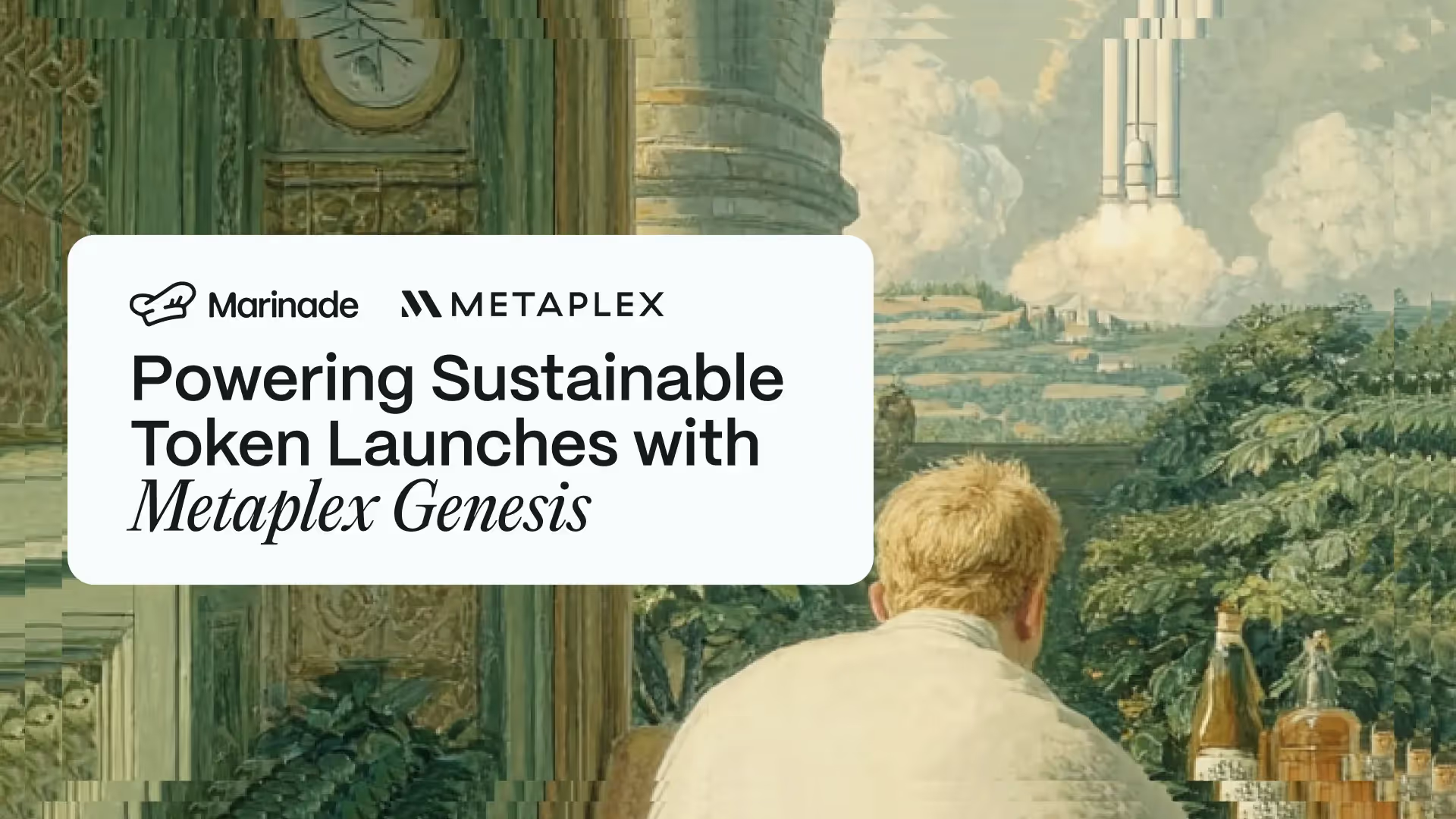Solana Staking 101
Learn the basics of staking on Solana, including how to start, the differences between native and liquid staking, and the role of validators. Discover how Marinade offers unique benefits for maximizing rewards and minimizing risks in the Solana ecosystem.

Intro
Among the many opportunities offered by blockchain technology, staking stands out as one of the most successful in achieving product-market fit. This is evidenced by the over $300 billion currently staked across various networks–Solana accounts for $68B of that. As a key feature of the Solana network, staking is essential to understand. This article provides a concise overview of how staking on Solana works, who can participate, the different types of staking, and, most importantly, how to start staking your Solana (SOL) tokens.
What Is Staking?
Solana operates under a “delegated proof of stake (DPoS)” consensus, which means all validators can receive delegation of stake from SOL holders as well as hold their own SOL tokens. Combined, the tokens held by the validator as well as received from stakers are known as the validator’s “stake.” If they’re inactive or dishonest, they may face penalties. You can read more on Solana’s proof of stake consensus mechanism here.
The primary actors in the staking process are validators, stakers, and users of a blockchain network. The Solana blockchain operates through a network of validators that verify transactions generated by the network’s users. Transactions are grouped into "blocks," which validators confirm for accuracy before they are sequentially stored in the blockchain’s data history.
Validators act as the primary overseers of the Solana blockchain, and for the network to function as intended, validators must be two things: active and honest.
It’s important that validators are always active, because if one or more validators stop validating transactions, the network’s security weakens due to fewer confirmations of each block’s accuracy. As a security measure, the Solana network automatically “halts” itself if 33% of the validators are simultaneously experiencing downtime.
It’s equally important that validators act in an honest manner. If validators collude to validate false data or fail to validate correct data, it can lead to serious consequences.
In order to incentivize validators to stay active and honest, the Solana network emits staking rewards in the form of SOL tokens to validators for validating blocks of transactions.
Who Can Stake On Solana?
Anyone can stake on Solana, however running a validator is very expensive and involves expenses pertaining to server space, hardware, commission, and more. In fact, break-even estimates for running a validator are typically over 100,000 SOL, which is almost $20 million at today’s price (Cogent Crypto has a profitability calculator here).
It goes without saying that the cost of profitably running a validator is unfeasible for most people, but thankfully there’s still a way to stake without having little to no cost burden. This is done by delegating your SOL to a validator, which essentially means depositing your SOL to a specific validator (or validators), having them earn staking rewards on your behalf, and transferring them back to you.
Most validators charge a commission for their services, which is the only cost of delegating your SOL. For example, if a validator charges 5% commission and earns you 10 SOL worth of staking rewards in a year, they get to keep 0.5 SOL and your net income is 9.5 SOL.
Types Of Staking And Respective Risks
The ease and convenience of earning rewards via staking on Solana has led to over 65% of the supply being staked. But before you stake, there are two types of staking that you should know about: native and liquid.
Native staking is the original and more common form of staking on Solana, commanding over 90% of the total staked SOL supply. Native staking simply means depositing your SOL tokens into a stake account, which is then delegated to one or more validators. This allows delegators to retain custody of their assets while earning staking rewards.
The main downside to native staking is once your SOL tokens are staked, their liquidity is “locked” up. Once the tokens are staked, you can select to unstake them at any time, and there’s a “cooldown period” between the time of unstaking and the time you can deposit. The cooldown period is typically 1 “epoch,” which is roughly 2 days; however, if the network is experiencing unusually large staking requests, the cooldown period may last 2-3 epochs. Otherwise, native staking bypasses other prominent risks such as smart contract risk and counterparty (i.e., custodial) risk.
While most staking services on Solana are native, liquid staking may appeal to active DeFi users who wish to retain as much liquidity as possible in their holdings.
Liquid staking is a relatively new form of staking, which has become increasingly popular since early-2023. Liquid staking allows users to maintain liquidity of their staked assets while also earning staking rewards. This duality is made possible with liquid staking tokens (LSTs), which are exchanged for SOL at the time of staking. For example, when you deposit SOL into Marinade’s liquid staking pool, you receive mSOL LSTs. The mSOL tokens naturally accrue staking rewards, which is reflected in their price. By retaining the liquidity of staked tokens, liquid stakers can then use their LSTs elsewhere in DeFi. For example, mSOL can be used to earn extra rewards by lending, LPing, and yield farming on various apps such as Kamino, Meteora, Raydium, and MarginFi.
While the liquidity offered by LSTs is extremely convenient, it’s important to know that you must redeem your original amount in order to withdraw your entire staked deposit. For example, if you deposit 10 SOL into Marinade liquid stake and receive 10 mSOL, and then lose 5 mSOL while trading, you’ll only be able to redeem 5 of your staked SOL.
Liquid staking also exposes stakers to other risks, including:
- Smart contract risk – deposited funds remain in custody of a smart contract while being staked with validators, which exposes them to potential vulnerabilities
- Liquidity risk – extreme volatility or illiquidity may cause the associated LST’s price to drift away from SOL’s price. However, liquid stakers can always exchange their msOL for SOL at the correct price by using the “delayed unstake” feature, which involves a 2-day cooldown period.
- Potentially losing your mSOL via high-risk activities, smart contract vulnerabilities, and other forms of exploits within the greater DeFi ecosystem.
Staking as a whole also carries downtime risk, which occurs if a validator that the staker is delegating to goes offline. In this case, the staker may miss out on staking rewards until the validator is back online.
How To Stake On Solana
In order to stake SOL, you’ll of course need to own SOL tokens. If you don’t currently own any, you can use a number of centralized exchanges or decentralized exchanges to purchase them. Here are some examples of each:
If you go the decentralized route, you’ll also need a Solana-compatible wallet. The most popular wallets (which also enable staking themselves) are Phantom and Solflare. You can find more information on how to set up each wallet below:
Once you have your SOL tokens and Solana wallet, you can stake however you wish: native, liquid, or a combination of both.
Native Staking
Native staking services are provided by a wide range of entities, including wallets like Solflare and Phantom, centralized exchanges like Coinbase and Kraken, and platforms like Marinade.
In general, using a decentralized app like Marinade opens the door for more efficiency and integration with other Solana ecosystem projects.
Additionally, with decentralized staking services, staking deposits are typically distributed to a large network of validators, rather than allocating the entire deposit to one or a few nodes. This not only contributes to the decentralization of the Solana network, it also helps smaller validators which tend to be overlooked during manual staking processes.
Liquid Staking
When it comes to liquid staking, the most popular options are all DeFi apps. In addition to Marinade’s liquid staking service, Jito and Solblaze offer their own liquid staking services. For more information about how Marinade compares to other Solana-based decentralized staking services, check out our comparison blog posts:
Marinade Staking Overview
One feature that sets Marinade apart from other services is that they offer both native and liquid staking. This is done to appeal to a broader audience of users; whether you’re an institutional staker who prefers the security maximization of native, or a retail user who’s active on many DeFi apps and wants the liquidity maximization of liquid, Marinade has a solution for everyone.
Marinade’s native and liquid staking services also have unique features to further minimize risk and maximize rewards. For example, Protected Staking Rewards (PSR) creates a buffer for stakers to continue to earn in the case the validators to which they’ve delegated their SOL experience downtime (downtime risk). The Stake Auction Marketplace (SAM) aims to increase rewards by allowing validators to bid for Marinade native staking deposits, which unlocks otherwise unavailable sources of rewards such as transaction fees and priority fees for delegators. It also allows validators to offset their commission rate by earning extra income via additional SOL delegation that they win via the auction process. For more information about these features, which are part of the broader Marinade v2 upgrade, check out our v2 blog post.
Conclusion
Staking with Marinade offers significant benefits for everyone involved. Stakers can earn optimized rewards via transaction and priority fees, validators can bid on additional SOL delegation which increases their income, and Solana users enjoy fast, low-cost transactions. Most importantly, network participation and usage grows, decentralizing in the process. Now, it’s your turn to join the ecosystem and start earning rewards on your SOL today!


